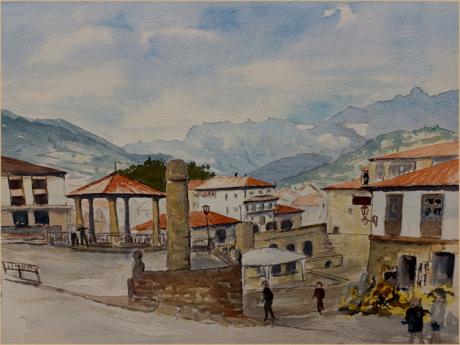" P Yates" and inscribed on the reverse
Unframed
Potes is a municipality in the autonomous community of Cantabria in Spain. It is the capital of the Comarca of Liébana and is located in the centre of it. It is bordered to the north by Cillorigo de Liébana, to the west by Camaleño, to the south by Vega de Liébana and to the east by Cabezón de Liébana.
The town of Potes is located at the confluence of four valleys, near where the River Quiviesa flows in the River Deva, the latter born at altitudes of the Picos de Europa. Like the rest of the Liébana region, Potes enjoys a Mediterranean microclimate that allows the cultivation of the vines, walnut and poplar. Overlooking the town is Arabedes mountain (694m).
Potes is located in a strategic location: at the point where the two rivers of Liébana meet: the Deva and its tributary the Quiviesa. There is little trace of prehistoric occupation in the region, but the Romans knew the power of strategic site and named it Pontes. A village was founded in the 8th century under Alfonso I of Asturias. Potes appeared for the first time in a document written in 847; the document mentions the parish church and the town. Later in the 10th century, thanks to its booming economy, Potes became the administrative centre of the Comarca of Liébana. Potes was considered a city from the 13th century and received royal recognition.
In the Becerro de Behetrías manuscript (1351), it appears as the property of Tello Alfonso, son of Alfonso XI of Castile. During the late Middle Ages, like all of Liébana, the town was involved in the confrontation between the families of Manrique Castañeda and Mendoza. In 1444, John II of Castile resolved the issue in favour of the Marquis of Santillana. The Marquis made Potes the capital of Liebana, and erected a large tower, called the Torre del Infantada. In this same period, prominent buildings such as the nearby Tower of Orejón de la Lama and the San Cayetano bridge were built.
In the modern age, Potes remained a place of manorialism. The Duke of Infantado appointed its mayor. Many villagers emigrated to America and the riches of the new continent allowed the construction of notable buildings in the village. In 1822, Potes received its own town council, being head of a judicial district covering Potes, Castro and Cillorigo, Cabezón de Liébana, Camaleño, Espinama, Pesaguero, Tresviso and Vega de Liébana. Thirty years later, it became part of the judicial district of San Vicente de la Barquera.
During the Spanish Civil War, Potes was hit by a fire caused by the Republican side that destroyed the old town, it was rebuilt afterwards. The old town was classified as a Conjunto Histórico in 1983.

